Mid-century modern design has stood the test of time, blending functionality with sleek, timeless aesthetics. Its clean lines, warm wood tones, and pops of color create a perfect balance of retro charm and contemporary style. For kitchens, this design trend offers a unique opportunity to combine practicality with a touch of vintage sophistication.
Whether someone is remodeling or starting fresh, mid-century modern kitchens bring a sense of character and elegance to any home. From bold backsplashes to minimalist cabinetry, these ideas showcase how to create a space that’s both stylish and highly functional. Dive into the top 20 mid-century modern kitchen ideas and discover inspiration to transform any cooking space into a design masterpiece.
Embrace Earthy Color Palettes
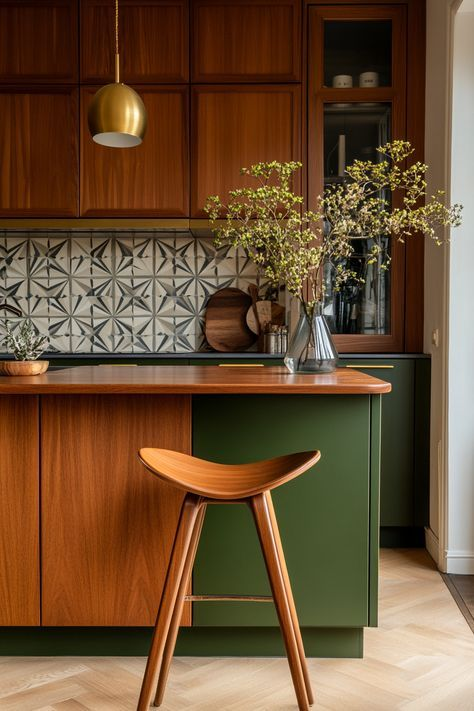
- Introduce warm neutrals for a cozy vibe. Incorporate shades like beige, taupe, or camel to create a soft and inviting atmosphere. These colors work beautifully on cabinets, walls, and kitchen islands, offering a subtle nod to mid-century modern charm.
- Blend deep greens and browns for natural depth. Use forest green or chocolate brown on accent walls, cabinetry, or backsplashes to emulate a nature-inspired look. Pair these hues with wood tones to enhance the earthy aesthetic.
- Lean into terracotta and ochre for bold accents. Choose terracotta tiles, ochre barstools, or statement decor pieces. These vibrant tones break up neutral backgrounds and add striking visual interest.
- Highlight wood finishes to tie the palette together. Opt for walnut or teak finishes on furniture, shelving, and trim. These rich wood tones complement earthy colors while anchoring the design in timeless mid-century modern style.
- Incorporate matte finishes for a cohesive look. Use matte paints, ceramic tiles, or muted textiles to maintain the understated flair of mid-century design. Avoid glossy surfaces which can detract from the organic feel.
Incorporate Sleek Cabinetry

Sleek cabinetry is a cornerstone of mid-century modern kitchen aesthetics. Prioritizing clean, minimalist designs ensures the space feels both functional and timeless.
Flat-Panel Doors
Choose flat-panel doors to achieve a streamlined and uncluttered look. These slab-style cabinets forego ornate detailing, allowing the simplicity of their geometry to shine. Opt for subtle hardware, like recessed pulls or thin tubular handles, to complement the clean lines. Materials like laminate or wood veneer work well and blend seamlessly with mid-century modern interiors.
Natural Wood Finishes
Integrate natural wood finishes to emphasize warmth and authenticity. Species like walnut, oak, or teak exude quintessential mid-century character. Highlight the wood’s natural grain by using stains that enhance, rather than mask, its texture. Pair these cabinets with muted or earthy tones to maintain a cohesive mid-century palette.
Add Iconic Mid Century Hardware

Adding iconic hardware brings an authentic touch to any mid-century modern kitchen. The right handles, knobs, and finishes can elevate the design effortlessly.
Geometric Knobs
Choose geometric knobs to infuse a retro yet timeless aesthetic. Opt for square, hexagonal, or circular designs made from wood, ceramic, or metal to echo the era’s love for clean forms. For example, use wood knobs in walnut or teak finishes to match the cabinetry, or pick matte black options for subtle contrast. Their sculptural detail adds character while maintaining functionality.
Brass or Copper Accents
Integrate brass or copper accents for a warm, metallic glow that complements mid-century palettes. Use brass pulls for drawers and copper handles for cabinets, ensuring the finishes are brushed or antiqued to avoid an overly polished look. These metals pair beautifully with earthy tones and natural wood, enhancing the cohesive vibe. For extra impact, include matching light fixtures or faucet hardware to tie the design together seamlessly.
Design with Functional Workspaces

- Prioritize work triangle efficiency
Position the stove, sink, and refrigerator in a triangular layout to maximize efficiency. This classic kitchen design principle minimizes steps and creates a seamless flow during meal preparation.
- Incorporate multi-purpose islands
Add a kitchen island with built-in storage, seating, or appliances. Opt for clean, rectangular shapes to reflect the mid-century modern style while maximizing functionality.
- Install versatile cabinetry
Use pull-out drawers, dividers, and lazy Susans for better organization. Flat-panel cabinets with natural wood finishes combine practicality with the era’s aesthetic.
- Use open shelving strategically
Include open shelves to display dishes or glassware while keeping essentials within reach. Choose minimalist designs with wood or metal accents to complement mid-century elements.
- Ensure ample counter space
Extend countertops along walls or into a peninsula for more workspace. Pair durable surfaces like quartz or butcher block with matte finishes to align with mid-century aesthetics.
- Integrate hidden appliances
Conceal appliances behind panel doors or use retro designs inspired by the 1950s and 60s. This maintains a clean look without disrupting the kitchen’s cohesive style.
- Include task lighting
Add under-cabinet lights or pendants above workspaces. Consider fixtures with geometric shapes or metals like brass for mid-century-inspired functionality and charm.
Include Bold Backsplashes

Mid-century modern kitchens thrive on expressive design details, and bold backsplashes are perfect for making a statement. From eye-catching patterns to vibrant tilework, these designs add flair and visual interest while staying true to the era’s playful yet sophisticated vibe.
Chevron Patterns
Chevron patterns bring dynamic geometry to mid-century modern kitchens. These V-shaped designs, often seen in tile arrangements, create a sense of movement and rhythm on the backsplash. Opt for colors like white and teal, mustard yellow, or soft gray to reflect the mid-century palette. Pairing chevron tiles with natural wood cabinets or minimalist countertops enhances the overall aesthetic, while the sharp angles bring balance to the clean lines of the space.
Vibrant Mosaic Tiles
Vibrant mosaic tiles introduce bursts of color and texture to the kitchen design. Tiles in hues like turquoise, coral, and golden yellow echo the bold tones popular in mid-century interiors. Choose small-scale mosaics for intricate detailing or larger pieces for a chunkier, retro look. Placing these tiles as a focal point behind the stove or sink draws attention, while blending them with neutral tones prevents overwhelming the space. Mosaic backsplashes work exceptionally well with light wood cabinetry and matte finishes.
Choose Retro-Inspired Appliances
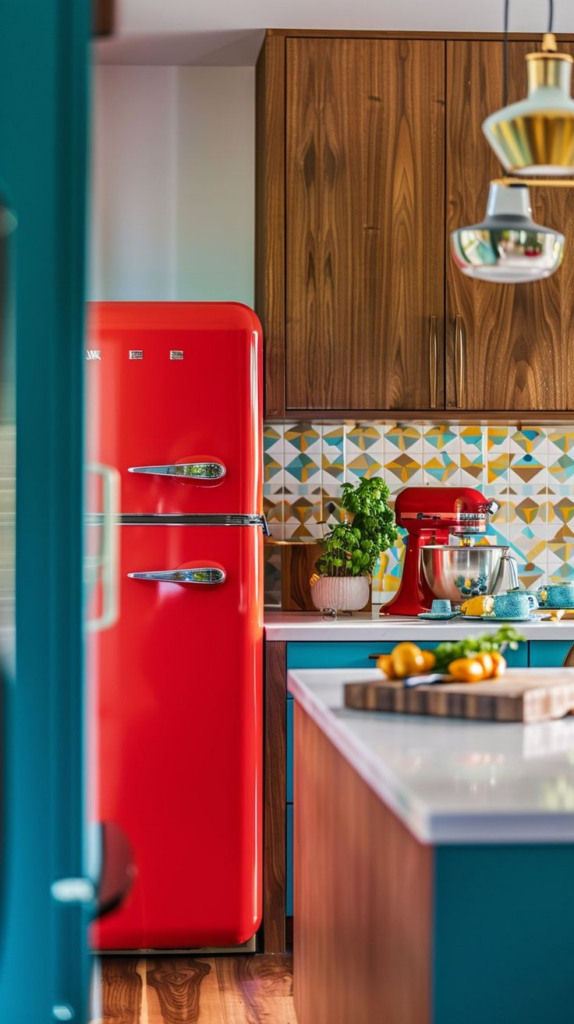
Retro-inspired appliances can add charm and authenticity to a mid-century modern kitchen. Opting for vintage-style designs paired with modern functionality creates a perfect blend of style and convenience.
Pastel Refrigerators
Pastel refrigerators, such as those in mint green, baby blue, or soft pink, embody the playful color schemes of the mid-century era. Brands like Smeg and Big Chill offer iconic designs with rounded edges and chrome accents that capture the vintage vibe. These fridges not only look stunning but also offer contemporary efficiency, making them ideal for a practical yet stylish kitchen centerpiece.
Rounded-Oven Ranges
Rounded-oven ranges are a quintessential nod to mid-century kitchen decor. Their curved edges, paired with retro-inspired knobs and metallic finishes, create a seamless connection to the design period. Companies like Elmira Stove Works provide models in classic colors like turquoise or butter yellow, adding a nostalgic flair while delivering modern cooking performance.
Feature Statement Lighting

Feature lighting plays a pivotal role in mid-century modern kitchens, offering both functionality and a bold design statement. Incorporating iconic lighting fixtures can instantly elevate the space while staying true to the era’s aesthetic.
Starburst Pendant Lights
Starburst pendant lights bring dynamic energy to a mid-century modern kitchen with their iconic sunburst-inspired design. Featuring metallic finishes like brass, gold, or bronze, these fixtures radiate warmth and sophistication. They pair seamlessly with natural wood tones and earthy color palettes, making them a perfect fit for this design style. Placing a starburst pendant above an island or dining area creates a striking focal point, blending form and function effortlessly. For added authenticity, opt for designs with slender rods and exposed bulbs, which are hallmark features of the mid-century aesthetic.
Sputnik Chandeliers
Sputnik chandeliers are quintessential mid-century modern fixtures that add drama and visual intrigue to any kitchen. Inspired by the 1957 launch of the Sputnik satellite, these chandeliers feature a central sphere with radiating arms, often topped with exposed bulbs. Their bold shapes and geometric form make them a great centerpiece over a dining table or a kitchen island. Available in finishes like matte black, polished chrome, or antique brass, they offer flexibility to match various mid-century palettes. Whether paired with sleek cabinetry or retro-inspired appliances, a Sputnik chandelier enhances the visual harmony of the space while maintaining its vintage charm.
Utilize Open Shelving Concepts

- Incorporate floating shelves for functionality and design. Open shelves instantly create a spacious feel and provide easy access to frequently used items. Opt for floating wooden shelves, especially in rich walnut or oak finishes, to complement the mid-century modern design. This style avoids heavy brackets, maintaining the clean and minimalist aesthetic.
- Stack simple dishware for a cohesive look. Display everyday essentials like plates, bowls, and glasses in neutral or muted tones to echo mid-century palettes. Sticking with sets in white, beige, or warm pastel shades ensures visual harmony while showing off the organized space.
- Add decor for visual interest. Layer the shelves with small potted plants, ceramic vases, or vintage glassware to enhance character and warmth. Choosing geometric or retro-inspired accents ties the decor to the mid-century theme without overpowering the space.
- Mix materials for a unique touch. Combine wood shelving with metal brackets or glass shelves in select areas to reflect the era’s use of mixed materials. Subtle brass tones or black accents on supports can add a modern, industrial edge while keeping the aesthetic grounded in mid-century style.
- Use lighting to highlight shelf displays. Incorporate under-cabinet lighting or spotlights to illuminate open shelving. This technique highlights decor and dishware while adding depth and elegance. Opt for warm light tones to align with the cozy, inviting atmosphere emblematic of mid-century kitchens.
- Keep clutter to a minimum. Open shelving works best when free of visual overload. Arrange items thoughtfully, leaving negative space to maintain the clean, open aesthetic central to mid-century modern design. Focus on balancing functionality with style to create an airy and organized look.
Merge Indoor and Outdoor Spaces

- Incorporate sliding glass doors
Sliding glass doors create a seamless transition between the kitchen and outdoor areas. By using large panels, homeowners can invite natural light while maintaining clear views of the outdoors. Frameless options or slim frames ensure the mid-century aesthetic stays unobstructed and airy.
- Use matching floor materials
Matching flooring materials indoors and outdoors blurs the boundary between spaces. For example, mid-century kitchens can utilize terrazzo or polished concrete to unify the design and enhance the connection across both areas.
- Add an outdoor dining area
An outdoor dining area adjacent to the kitchen can extend functionality. Incorporating a teak or acacia wood dining set reflects mid-century style and complements the warm wood tones often found in mid-century kitchens.
- Install a pass-through window
Pass-through windows simplify serving between the kitchen and outdoor spaces. Using a wide, operable design framed in wood or metal adds to the mid-century modern charm and promotes practicality.
- Incorporate potted plants
Adding plants like succulents or snake plants indoors and outdoors establishes continuity. Placing them near large windows, sliding doors, or on shared surfaces enhances the organic mid-century aesthetic.
- Include outdoor-inspired decor
Using outdoor-inspired elements, like woven furniture, stone textures, and wooden planters, brings the outdoors inside. These additions complement the natural warmth central to mid-century modern design.
- Leverage mid-century lighting
Placing iconic mid-century lights in both indoor and outdoor areas creates cohesive ambiance. Pendant lights over indoor islands and similar outdoor fixtures ensure design continuity while maintaining a vintage feel.
- Design a covered patio
Creating a covered patio connected to the kitchen offers versatility. Finished with retro-inspired furniture and geometric decor, it extends the mid-century design while providing a functional outdoor retreat.
- Integrate biophilic features
Features like vertical green walls or simple wooden pergolas enhance the indoor-outdoor connection. These biophilic elements pair beautifully with natural finishes and earthy palettes found in mid-century modern kitchens.
Incorporate Vintage Bar Stools

Vintage bar stools add both functionality and character to a mid-century modern kitchen. Their sleek designs and retro details seamlessly complement the era’s aesthetic, creating a perfect balance between style and practicality.
Upholstered Seating
Choose upholstered bar stools with durable fabrics in vibrant or earthy tones. Options like leather or tweed upholstery in shades of mustard, olive green, or burnt orange nod to the mid-century palette. Button-tufted detailing or smooth, clean surfaces elevate the retro look while providing comfortable seating. Pairing these stools with a wood or metal base ensures a cohesive design that’s both chic and cozy.
Metallic Bases
Opt for bar stools with metallic bases to highlight the industrial elegance of mid-century modern design. Polished chrome or brushed brass finishes add a touch of sophistication. Look for sleek, minimalist frames or tapered legs that emphasize clean lines. Combining metallic bases with wood accents, such as walnut seats or armrests, creates a balanced aesthetic that ties into the overall kitchen decor.
Highlight Geometric Flooring

Geometric flooring plays a transformative role in mid-century modern kitchens, infusing bold patterns and timeless charm. The use of dynamic designs adds visual depth and authenticity to the space.
Terrazzo Tiles
Terrazzo tiles offer a statement-making flooring option that embodies the mid-century modern aesthetic. Featuring a mix of marble, quartz, and granite chips set in concrete, these tiles boast a distinctive speckled pattern. They come in a variety of earthy tones like beige, taupe, and gray, perfectly complementing wood finishes commonly seen in mid-century spaces. For added authenticity, opt for tiles with larger chips to replicate the classic mid-century terrazzo look.
Checkerboard Patterns
Checkerboard patterns evoke a retro vibe while maintaining the clean sophistication of mid-century design. Black-and-white tiles are a timeless option, creating striking contrast and sharp lines. For a more subdued palette, try alternating neutral shades like charcoal and cream. This pattern pairs beautifully with wood cabinetry and metallic accents, offering a harmonious balance of boldness and warmth in mid-century modern kitchens.
Showcase Glass Cabinet Doors

Highlighting glass cabinet doors is a stylish way to add visual interest to a mid-century modern kitchen. These cabinets combine practicality and design, displaying curated dishware and decor while maintaining an airy aesthetic.
- Incorporate frosted glass for a sleek look. Use frosted or etched glass panels to provide a subtle nod to mid-century design while concealing clutter for a clean appearance. Pair frosted glass with wooden or metallic trims in shades like walnut or brushed brass for a cohesive finish.
- Use clear glass for an open feel. Showcase polished glass panels to emphasize openness and allow vibrant dishware or glassware to take center stage. Position clear glass cabinets above countertops to create visual height and expand the room’s overall brightness.
- Add geometric patterns for retro appeal. Choose etched or stained glass with geometric motifs like grids or starbursts to reflect mid-century modern artistry. These patterns add texture and tie the cabinetry to other retro-inspired elements, like lighting or backsplashes.
- Opt for sliding glass panels for functionality. Install sliding glass cabinet doors to save space and enhance accessibility, blending mid-century functionality with modern convenience. Ensure the hardware aligns with the kitchen’s aesthetic, using minimalist tracks in muted metallic tones.
- Back cabinets with vibrant hues. Paint the interiors of glass cabinets in bold mid-century colors like mustard yellow, mint green, or burnt orange. This detail introduces playful pops of color while keeping the rest of the space understated.
- Layer lighting inside cabinets. Add interior lighting to glass cabinets to highlight displayed items and create ambiance. Warm LED lighting works well for mid-century kitchens, emphasizing textures and tones within the cabinetry without overpowering the design.
Implement Solid Wood Countertops

- Select durable wood species like walnut or oak
Opt for hardwoods such as walnut, oak, or maple to enhance both longevity and the warm, natural aesthetic central to mid-century modern design. These species resist wear and develop a rich patina over time, adding timeless charm to the kitchen.
- Use finishes to protect the wood
Apply food-safe oils or polyurethane finishes to seal countertops, preventing moisture damage while highlighting the wood’s natural grain. Matte finishes align with mid-century aesthetics, maintaining an organic and understated appearance.
- Incorporate butcher block styles for added functionality
Choose butcher block designs for a versatile surface that doubles as a prep station. The clean lines and natural wood tones seamlessly integrate with mid-century cabinetry and color palettes.
- Pair wood countertops with earthy and neutral tones
Complement the warm wood hues with cabinetry in muted shades like olive green, cream, or taupe. This enhances the harmonious and inviting ambiance typical of mid-century modern kitchens.
- Utilize contrasting edges or inlays for visual interest
Add a modern twist by incorporating beveled edges or contrasting wood inlays. This subtle detail reflects the mid-century focus on craftsmanship and clean geometries while personalizing the countertop.
- Care for solid wood regularly to maintain quality
Prevent wear by periodically sanding and reapplying protective finishes. Proper maintenance extends the countertop’s life and ensures it remains a focal point within the mid-century modern kitchen.
Add Large Windows for Natural Light

Install large windows to make the most of natural light in a mid-century modern kitchen. Opt for expansive panes with minimal framing to maximize sunlight and emphasize the clean lines central to this design style. Floor-to-ceiling windows or wide horizontal layouts can create a connection to the outdoors, making the space feel open and inviting.
Choose materials like aluminum or wood for window frames to stay true to the mid-century aesthetic. Wood frames, especially in walnut or teak finishes, add warmth, while aluminum provides a sleek, modern contrast. Incorporate glazing options like low-E glass to improve energy efficiency and maintain indoor temperature without sacrificing light.
Position windows strategically to enhance both functionality and aesthetics. Installing them above countertops or near the sink can provide light in working spaces, while corner windows add architectural interest. Pair these windows with earthy-toned Roman shades or sheer curtains to soften the lighting when needed and maintain privacy without overpowering the design.
Integrate window designs that prioritize symmetry and align with mid-century architecture. Consider clerestory windows for their ability to draw in light while preserving privacy, or combine a large central pane with smaller side panels to create a balanced, geometric look. Complement the windows with surrounding elements, like wooden cabinetry or terrazzo floors, to create a seamless flow that highlights mid-century modern charm.
Mix Textures and Materials
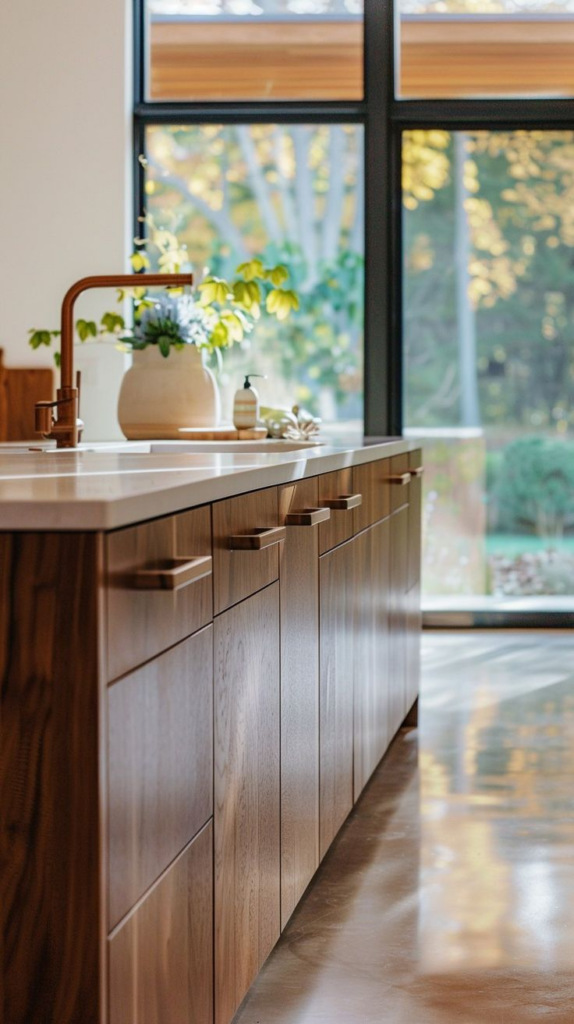
- Combine wood and metal finishes
Pair natural wood with metallic accents to embody mid-century charm. For example, walnut cabinets can be combined with brushed brass handles for a warm and cohesive look. Copper light fixtures or steel shelving brackets also add depth and contrast.
- Incorporate matte and glossy elements
Balance matte cabinetry with glossy backsplashes or appliances. A matte navy pantry paired with a glossy white subway tile backsplash can create an understated but chic aesthetic. This mix highlights both finishes without overpowering the space.
- Layer natural and synthetic materials
Use a mix of organic and manufactured surfaces for a dynamic design. Think solid wood countertops with laminate finishes or terrazzo flooring combined with polycarbonate chairs. These contrasts create visual interest and reflect the era’s balance of nature and innovation.
- Blend textiles like leather and fabric
Add upholstered elements such as leather bar stools alongside fabric kitchen cushions. Mid-century palettes like mustard, olive green, or neutral tweed textures can soften the look and add comfort to seating.
- Use varied tile patterns and sizes
Mix geometric tiles with complementary plain designs. For example, a hexagonal tile backsplash can pair well with large, simple square tiles on the floor. Introducing textures like ridged or beveled tiles also enhances visual depth and variety.
- Add glass and wood combinations
Blend frosted glass cabinet doors with wood frames in warm tones like teak or oak. This mix provides transparency and structure, maintaining the balance between openness and mid-century solidity.
- Incorporate contrasting decor accents
Accessorize with a mix of ceramic vases, woven baskets, and metallic planters. A ceramic urn with a brushed metal base, sitting on a wooden shelf, showcases a thoughtful interplay of textures and materials.
Install Mid Century-Inspired Fixtures
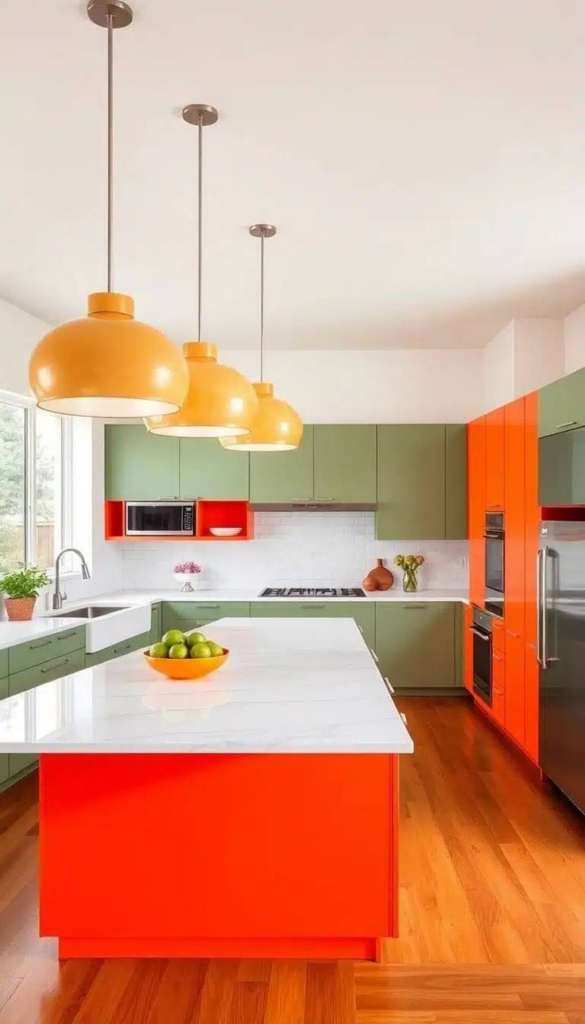
Incorporating mid-century-inspired fixtures can instantly elevate the kitchen’s aesthetic, blending vintage charm with modern functionality. Focus on streamlined designs and carefully selected finishes to achieve an authentic look.
Pot Filler Faucets
Add a pot filler faucet above the stove to combine convenience with mid-century style. Choose fixtures with clean lines and metallic finishes like brushed brass or matte black to reflect the era’s aesthetic. Wall-mounted designs enhance practicality while their minimalistic form seamlessly integrates with mid-century modern kitchens. Pairing a pot filler with complementary hardware ensures a cohesive and polished appearance.
Minimalistic Handles
Opt for minimalistic handles to emphasize clean lines and simplicity. Streamlined options such as tubular pulls, recessed grips, or flat bar handles nod to the understated elegance of mid-century design. Materials like brushed nickel, brass, or matte black provide subtle sophistication, while finishes like antiqued brass align with the warm tones often found in mid-century kitchens. Avoid ornate styles to maintain the era’s minimalist vibe.
Include Pop Art or Abstract Decor

Integrating Pop Art or abstract decor introduces a playful and artistic vibe to mid-century modern kitchens. These elements allow homeowners to celebrate the era’s love for bold creativity and vibrant expression.
Framed Artwork
Displaying framed Pop Art on walls adds a dramatic flair to the kitchen. Choose iconic works reminiscent of the 1950s and 1960s, such as pieces inspired by Andy Warhol or Roy Lichtenstein, to evoke the era. Opt for large-scale prints in vivid colors to serve as a statement piece. Frames with slim metallic finishes or simple wood designs ensure cohesiveness with the mid-century aesthetic. Position the art strategically above a breakfast nook, near open shelving, or on a backsplash wall to draw attention.
Sculptural Accessories
Incorporating sculptural decor enhances the artistic appeal while maintaining functionality. Ceramic vases, geometric metal sculptures, or wooden art objects reflect the era’s emphasis on clean forms and abstract design. Items in bold shades like orange, teal, or mustard tie into mid-century palettes, while natural materials like walnut or teak add warmth. Display these accessories on countertops, floating shelves, or in glass-front cabinets to balance visual interest without overcrowding the space. Rotate between contemporary and vintage pieces to keep the decor dynamic yet authentically aligned with the mid-century modern style.
Create Warm and Inviting Dining Areas
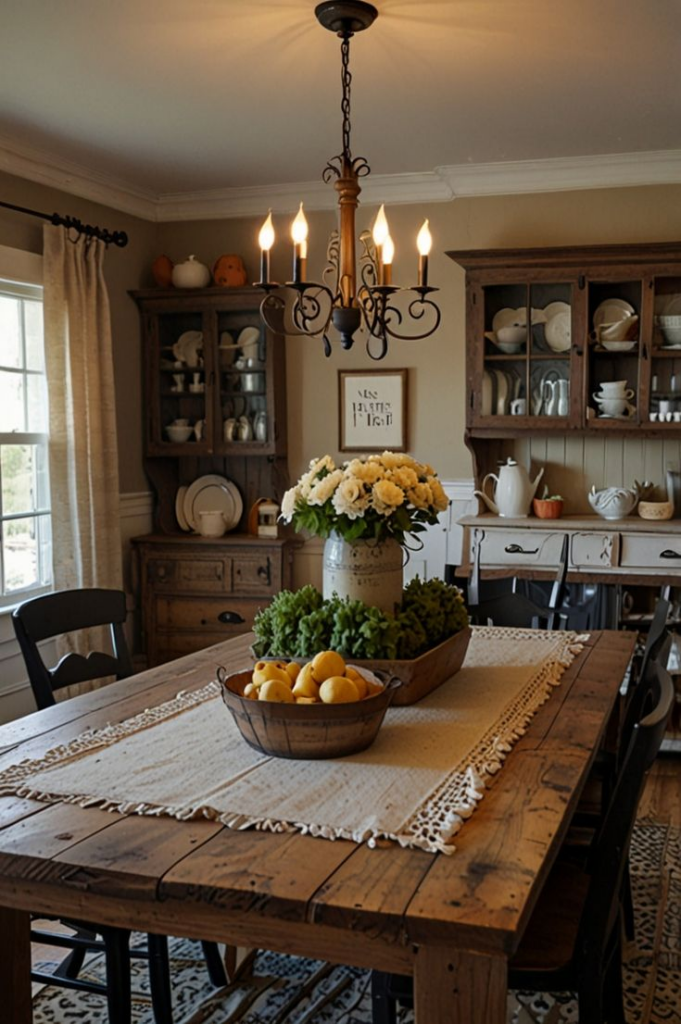
- Use natural wood dining furniture
Choose a dining table and chairs made from warm-toned woods like walnut or teak. These materials add a cozy and authentic mid-century feel. Opt for designs with clean lines and tapered legs to match the era’s aesthetic.
- Incorporate upholstered seating
Add upholstered dining chairs or benches in earthy fabrics like tweed, boucle, or leather. Colors like burnt orange, mustard yellow, or olive green can evoke the vibrant yet warm palette that defines mid-century design.
- Add pendant lighting above the table
Install a statement pendant light, such as a starburst or dome-shaped fixture, to provide illumination and enhance the retro charm. Brass or matte finishes work well to tie in with other mid-century elements.
- Layer the space with a vintage rug
Place a patterned rug under the dining table to introduce texture and warmth. Look for geometric prints or muted tones that harmonize with the overall color scheme without overpowering the space.
- Display mid-century dinnerware
Use open shelving or a glass-front cabinet to showcase vintage-inspired plates, bowls, and glasses. Choose pieces with bold colors, geometric patterns, or unique shapes to reflect the playful side of mid-century modern design.
- Utilize plants for natural warmth
Place potted plants like fiddle leaf figs or snake plants near the dining area. These add a bit of greenery and complement the organic materials typical of mid-century interiors.
- Incorporate built-in banquette seating
Create a cozy and functional dining nook with a built-in bench. Pair it with a round or oval table to soften the lines and enhance the inviting ambiance. Use cushions or pillows in mid-century-inspired fabrics to increase comfort.
- Focus on an open-plan layout
Ensure the dining area flows seamlessly into the kitchen or living space. Open layouts were a hallmark of mid-century homes and help create a more welcoming and communal atmosphere.
- Decorate with minimalistic art
Add wall art with abstract designs or Pop Art pieces featuring bold colors or simple forms. These elements elevate the dining area’s visual interest while maintaining the mid-century modern theme.
- Enhance ambiance with dimmable lighting
Install dimmers on your light fixtures to create a warm, adjustable glow for different times of the day. This flexibility keeps the dining area feeling inviting whether it’s a casual meal or evening gathering.
Use Minimalistic Wall Art

- Choose simple designs
Opt for minimalistic artwork featuring clean lines, abstract shapes, or muted tones. Pieces with a focus on geometry or subtle patterns work well in mid-century modern kitchens, aligning with the era’s preference for understated elegance.
- Pick neutral or earthy palettes
Incorporate art in colors like beige, taupe, or soft green to complement the mid-century modern color scheme. These hues blend seamlessly with wood tones, matte finishes, and natural stone often found in these kitchens.
- Frame with sleek materials
Select thin metal or wood frames to maintain a minimalist aesthetic. Black, brass, or walnut-tone frames enhance the artwork’s clean and simple look without overwhelming the space.
- Hang strategically
Place wall art above counters, near dining nooks, or on accent walls to draw attention without cluttering the layout. Ensure the positioning complements other design elements like shelving, lighting, or cabinetry.
- Incorporate series or grids
Use a series of small artworks arranged in a grid or row for a balanced display. Stick to consistent frame designs and cohesive themes to avoid disrupting the space’s visual harmony.
- Add textural pieces
Include woven wall hangings or wood-relief art for added texture. These items nod to the natural materials central to mid-century design, enhancing the organic ambiance of the kitchen.
- Keep proportion in mind
Choose artwork that fits the kitchen’s scale. Large pieces can dominate small spaces, while tiny pieces get lost in expansive layouts. Balance size to ensure the space feels cohesive and well-curated.
- Coordinate with decor
Align artworks with surrounding colors, patterns, or materials, such as matching muted shades from backsplash tiles or wood accents. This consistency strengthens the overall mid-century modern style.
Bring in Plants and Greenery

Incorporate indoor plants to infuse life into mid-century modern kitchens. Choose low-maintenance options like pothos, snake plants, or peace lilies, which thrive in various lighting conditions. Position them on countertops, open shelves, or window sills to add natural charm without overwhelming the space.
Elevate the aesthetic by using mid-century-inspired planters. Opt for ceramic pots in muted tones, geometric designs, or stands with tapered wooden legs that reflect the era’s style. Combining these with the greenery enhances the organic appeal of the design.
Add hanging plants to maximize vertical space. Suspend planters with macrame hangers or sleek metal brackets above kitchen islands or near windows, blending function with visual interest. This method brings depth and greenery without interrupting the clean lines central to mid-century design.
Integrate vertical plant arrangements for a statement piece. Install a living wall with modular planters, or arrange a collection of small potted plants on tiered shelves. These features highlight biophilic design while maintaining a cohesive mid-century modern look.
Include herbs for both style and utility. Place small pots with basil, mint, or rosemary near cooking areas for a fresh touch. Use matching containers in natural materials like wood or terracotta to keep consistency with the mid-century aesthetic.
Conclusion
Mid-century modern kitchens effortlessly blend timeless design with practical functionality, offering a perfect harmony of style and utility. By embracing iconic elements like clean lines, natural materials, and bold accents, homeowners can create a space that’s both inviting and sophisticated.
Whether through retro-inspired appliances, geometric patterns, or earthy palettes, these kitchens exude a charm that stands the test of time. Thoughtful touches like statement lighting, open shelving, and seamless indoor-outdoor connections enhance their appeal while maintaining practicality.
With endless possibilities to personalize and adapt, mid-century modern kitchens remain a captivating choice for those seeking a balance of vintage elegance and modern convenience.
